In a world where security and convenience intertwine, the ability to remember and manage four-digit codes has become a crucial skill. From unlocking smartphones to accessing secure accounts, four-digit codes are a common security measure designed to protect personal information. This article explores the significance of memorizing these codes, offers effective techniques to enhance memory, and discusses various applications where this skill is beneficial.
The Importance of Memorizing Four-Digit Codes
Four-digit codes are ubiquitous in today’s digital age. They serve as a simple yet effective means of authentication and security. Understanding their importance helps underscore why mastering this skill is valuable:
- Security: Four-digit codes are often used as part of multi-factor authentication (MFA) systems, providing an additional layer of security beyond passwords. Knowing your code means you can access your accounts securely without relying on others.
- Convenience: Memorizing your four-digit codes eliminates the need to write them down or store them in less secure places. This not only enhances convenience but also reduces the risk of code theft.
- Efficiency: For frequent users of security systems that utilize four-digit codes, such as ATMs or secure entry systems, quick and accurate recall of these codes speeds up transactions and access.
Effective Techniques for Memorizing Four-Digit Codes
Memorizing a four-digit code might seem simple, but effective techniques can make the process even easier. Here are some strategies to enhance your memory for these codes:
- Association and Visualization:
- Create a Story: Associating each digit with a memorable event or object can help. For example, if your code is 4729, you might visualize a scenario where you encounter four ducks (4) and two cats (2) in a park on a sunny day (9).
- Use Mnemonics: Develop a mnemonic device where each number represents a word. For instance, if your code is 1234, you could use “A Big Cat Danced” to remember the digits (A=1, Big=2, Cat=3, Danced=4).
- Repetition and Practice:
- Write It Down: Initially, write the code down repeatedly to reinforce it in your memory. Gradually reduce reliance on written notes and focus on mental recall.
- Practice Regularly: Incorporate the code into daily routines. For instance, if you use it to unlock your phone or access secure areas, consistently practice entering the code to build muscle memory.
- Chunking and Segmentation:
- Break It Down: Divide the code into smaller, manageable chunks. Instead of memorizing 1234 as a single sequence, think of it as 12 and 34. This technique leverages the brain’s ability to remember smaller groups of information more effectively.
- Use of Memory Aids:
- Create Patterns: Look for patterns or sequences within the code. A code like 2468 might be easier to remember because it follows an ascending sequence of even numbers.
- Incorporate Familiar Numbers: Use numbers that have personal significance, such as important dates or lucky numbers. A code like 1987 might be easier to remember if it’s associated with a significant year in your life.
Applications of Four-Digit Codes
Understanding where and how four-digit codes are used can further highlight their importance and the need for effective memorization. Here are some common applications:
- Banking and ATMs:
- ATM PINs: Personal Identification Numbers (PINs) for ATM transactions typically consist of four digits. Memorizing your ATM PIN is crucial for secure access to your funds and avoiding potential fraud.
- Mobile Devices:
- Phone Lock Codes: Smartphones often use four-digit codes to unlock the device. Memorizing this code ensures that you can quickly access your phone while keeping it secure from unauthorized users.
- Access Control Systems:
- Office Buildings: Many businesses use four-digit codes to control access to secure areas. Memorizing these codes ensures that employees can enter restricted areas without delay.
- Online Accounts:
- Security Codes: Some online accounts use four-digit codes as part of their security measures. This might include authentication codes sent to your phone or email, which you need to enter to verify your identity.
- Public Transport:
- Ticket Machines: Public transportation systems often use four-digit codes for ticket purchases or entry. Memorizing these codes can streamline your travel experience.
Challenges and Solutions
Despite their simplicity, four-digit codes can pose challenges, especially when managing multiple codes. Here are common challenges and potential solutions:
- Forgetting Codes:
- Solution: Use secure password managers to store and recall your codes. These tools can help manage multiple codes securely without the need to remember each one.
- Code Security:
- Solution: Avoid using easily guessable codes, such as 1234 or 0000. Instead, choose codes that are less predictable and incorporate a mix of numbers.
- Code Conflicts:
- Solution: When managing multiple codes, try to use different codes for different systems or purposes. This reduces the risk of confusion and potential security issues.
Conclusion
Memorizing four-digit codes is a practical skill that enhances security, convenience, and efficiency in various aspects of daily life. By employing effective memorization techniques, understanding the significance of these codes, and addressing common challenges, individuals can manage their codes confidently and securely. Whether for banking, mobile devices, or access control systems, mastering the art of remembering four-digit codes is essential in today’s digital world.

